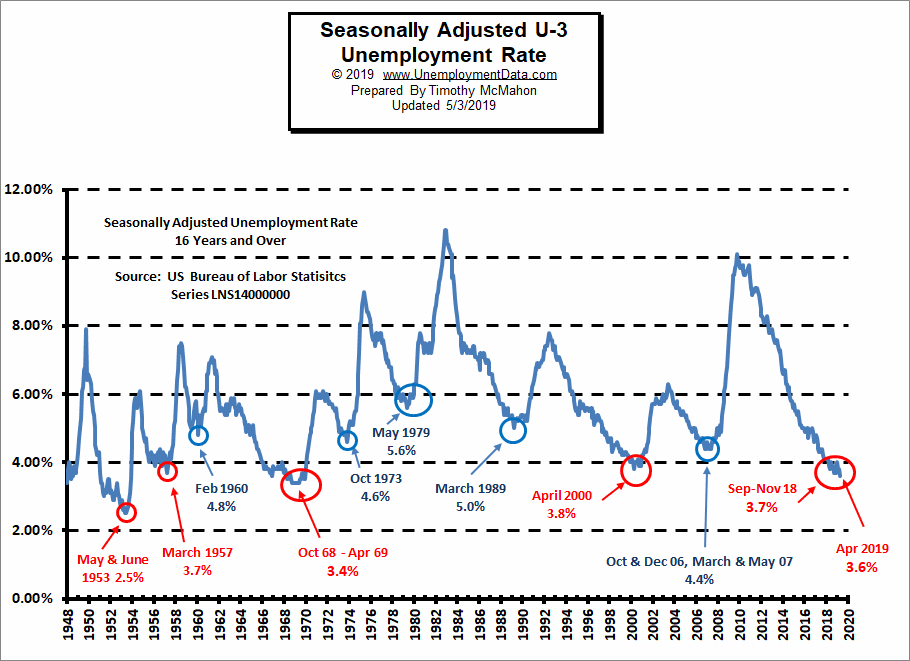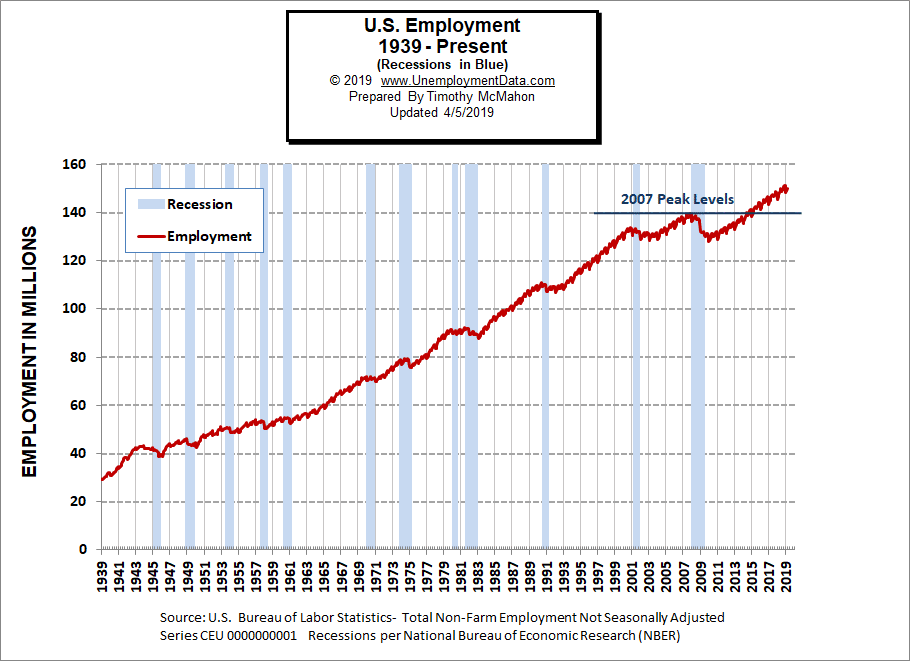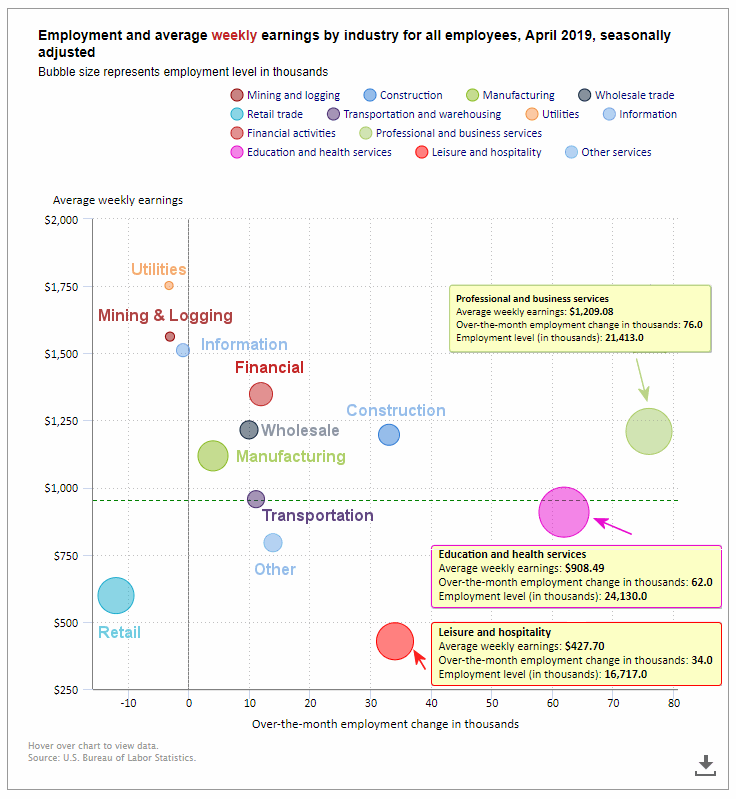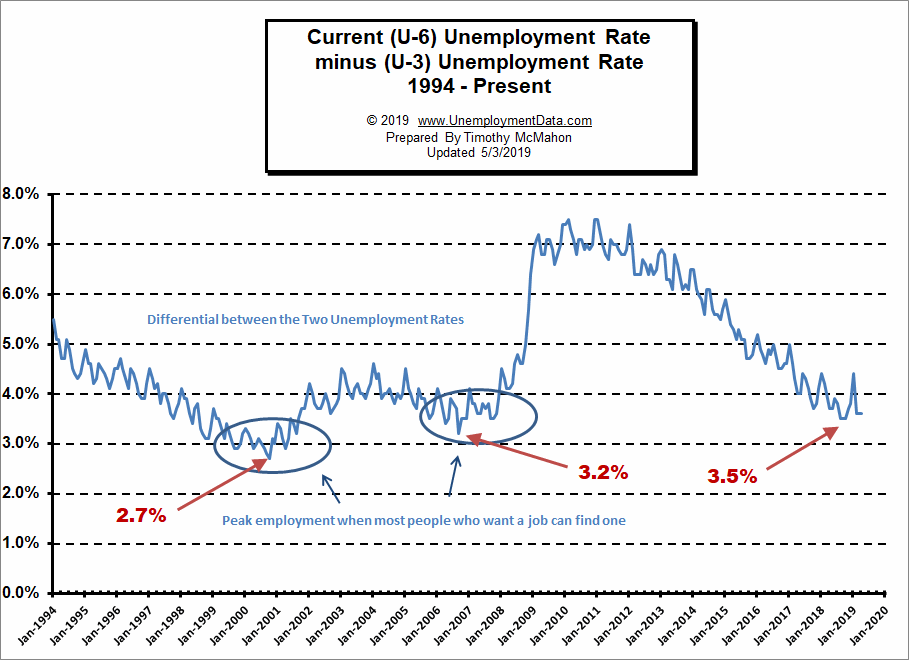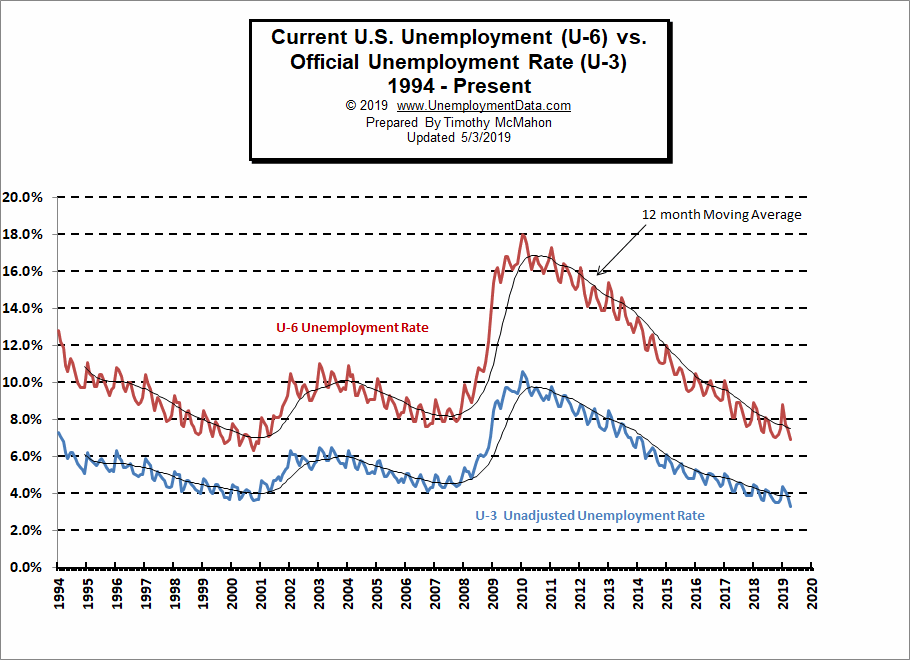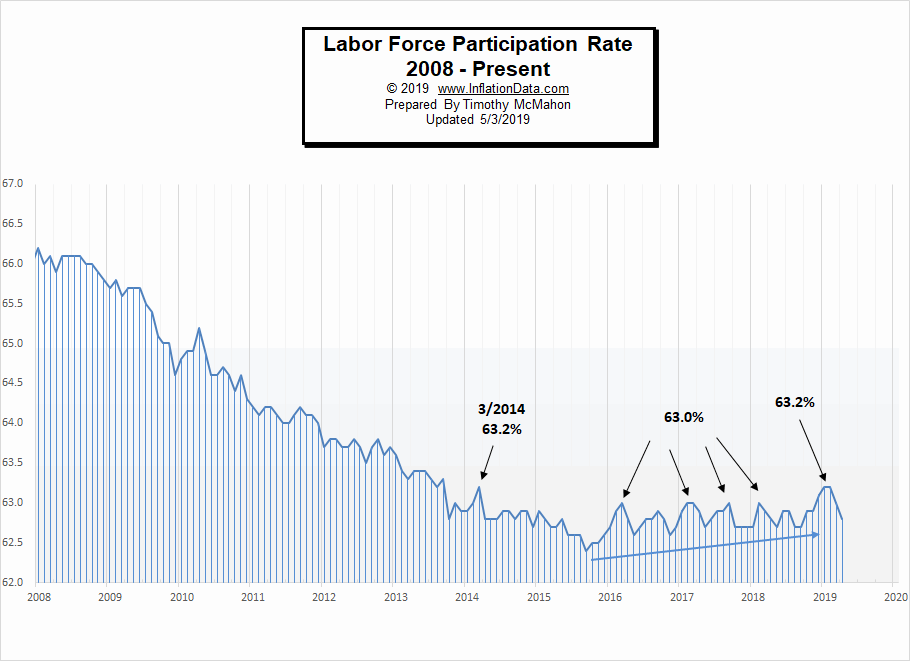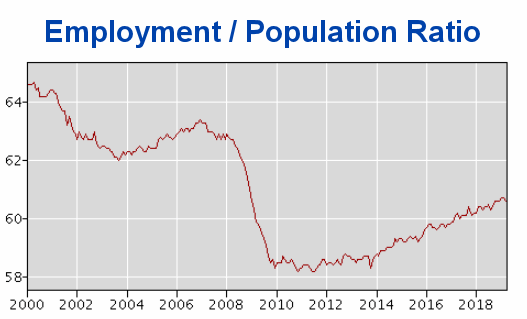![]() The U.S. Bureau of Labor Statistics (BLS) released their monthly unemployment survey results for April on May 3rd and it is much better than anyone expected.
The U.S. Bureau of Labor Statistics (BLS) released their monthly unemployment survey results for April on May 3rd and it is much better than anyone expected.
According to the U.S. Bureau of Labor Statistics:
The U.S. economy created 263,000 jobs in April and the seasonally adjusted unemployment rate dropped to 3.6 percent.
That far exceeded the 180,000 estimated by economists. Last month the economists projected a 175,000 jobs gain and instead got 196,000 for two excellent months in a row.
According to the BLS Commissioner’s report for this month:
“In April, nonfarm payroll employment increased by 263,000, and the unemployment rate declined to 3.6 percent. Over the month, notable job gains occurred in professional and business services, construction, health care, and social assistance. The April employment gain compares with an average monthly gain of 213,000 over the prior 12 months. (The prior 12-month average incorporates revisions for February and March, which increased nonfarm payroll employment by 16,000 on net.)”
Key factors in the report were:
Employment in professional and business services increased by 76,000…
Construction employment rose by 33,000…
Employment in health care increased by 27,000…
Seasonally Adjusted U-3 Unemployment is the lowest rate since December 1969.
Of course the Commissioner is talking about “Seasonally Adjusted” jobs. In unadjusted terms March had 149.862 million jobs while April had 150.988 million jobs for an actual increase of 1,126,000 jobs.
For more info see our Current Unemployment Chart and Current U.S. Employment Chart commentary:
Key April Employment and Unemployment Numbers
- Adjusted U-3 Unemployment- 3.6% Down from 3.8% in March
- Unadjusted U-3 Unemployment- 3.3% down from 3.9% in March and 4.1% in February, and 4.4% in January.
- Unadjusted U-6 Unemployment- 6.9% down from 7.5% in March, 7.7% in February and 8.8% in January, 7.5% in December.
- Unadjusted Employment (Establishment Survey)- 150.988 million up from 149.862 million in March, 149.143 million in February and 148.295 million in January.
- Labor Force Participation Rate- 62.8% down from 63.0% in March and from the peak of 63.2% in February.
Current Seasonally Adjusted U-3 levels are below the 3.8% lows of 2000. Prior to that we have to go all the way back to 1969 to see better unemployment levels than we have currently. If we break below 3.4% we have to go all the way back to 1953 to find lower levels and remember that was during the boom that followed WWII with a massive loss of the workforce due to the war so we probably won’t see levels that low again.
The 1969 lows occurred during the Vietnam war. Prior to 1969 was a low of 3.7% in 1957.
See Current Unemployment Chart for more info.
Previous Record Low Unemployment (Seasonally Adjusted U-3)
If we consider anything 4% or below as “low” we have had a few “low” stretches as we can see in the table below.
(4% or below in Blue)
| Jan | Feb | Mar | Apr | May | Jun | Jul | Aug | Sep | Oct | Nov | Dec | |
| 1950 | 6.5% | 6.4% | 6.3% | 5.8% | 5.5% | 5.4% | 5.0% | 4.5% | 4.4% | 4.2% | 4.2% | 4.3% |
| 1951 | 3.7% | 3.4% | 3.4% | 3.1% | 3.0% | 3.2% | 3.1% | 3.1% | 3.3% | 3.5% | 3.5% | 3.1% |
| 1952 | 3.2% | 3.1% | 2.9% | 2.9% | 3.0% | 3.0% | 3.2% | 3.4% | 3.1% | 3.0% | 2.8% | 2.7% |
| 1953 | 2.9% | 2.6% | 2.6% | 2.7% | 2.5% | 2.5% | 2.6% | 2.7% | 2.9% | 3.1% | 3.5% | 4.5% |
| 1954 | 4.9% | 5.2% | 5.7% | 5.9% | 5.9% | 5.6% | 5.8% | 6.0% | 6.1% | 5.7% | 5.3% | 5.0% |
| 1955 | 4.9% | 4.7% | 4.6% | 4.7% | 4.3% | 4.2% | 4.0% | 4.2% | 4.1% | 4.3% | 4.2% | 4.2% |
| 1956 | 4.0% | 3.9% | 4.2% | 4.0% | 4.3% | 4.3% | 4.4% | 4.1% | 3.9% | 3.9% | 4.3% | 4.2% |
| 1957 | 4.2% | 3.9% | 3.7% | 3.9% | 4.1% | 4.3% | 4.2% | 4.1% | 4.4% | 4.5% | 5.1% | 5.2% |
| 1958 | 5.8% | 6.4% | 6.7% | 7.4% | 7.4% | 7.3% | 7.5% | 7.4% | 7.1% | 6.7% | 6.2% | 6.2% |
| … | … | … | … | … | … | … | … | … | … | … | … | … |
| 1965 | 4.9% | 5.1% | 4.7% | 4.8% | 4.6% | 4.6% | 4.4% | 4.4% | 4.3% | 4.2% | 4.1% | 4.0% |
| 1966 | 4.0% | 3.8% | 3.8% | 3.8% | 3.9% | 3.8% | 3.8% | 3.8% | 3.7% | 3.7% | 3.6% | 3.8% |
| 1967 | 3.9% | 3.8% | 3.8% | 3.8% | 3.8% | 3.9% | 3.8% | 3.8% | 3.8% | 4.0% | 3.9% | 3.8% |
| 1968 | 3.7% | 3.8% | 3.7% | 3.5% | 3.5% | 3.7% | 3.7% | 3.5% | 3.4% | 3.4% | 3.4% | 3.4% |
| 1969 | 3.4% | 3.4% | 3.4% | 3.4% | 3.4% | 3.5% | 3.5% | 3.5% | 3.7% | 3.7% | 3.5% | 3.5% |
| 1970 | 3.9% | 4.2% | 4.4% | 4.6% | 4.8% | 4.9% | 5.0% | 5.1% | 5.4% | 5.5% | 5.9% | 6.1% |
| … | … | … | … | … | … | … | … | … | … | … | … | … |
| 1999 | 4.3% | 4.4% | 4.2% | 4.3% | 4.2% | 4.3% | 4.3% | 4.2% | 4.2% | 4.1% | 4.1% | 4.0% |
| 2000 | 4.0% | 4.1% | 4.0% | 3.8% | 4.0% | 4.0% | 4.0% | 4.1% | 3.9% | 3.9% | 3.9% | 3.9% |
| 2001 | 4.2% | 4.2% | 4.3% | 4.4% | 4.3% | 4.5% | 4.6% | 4.9% | 5.0% | 5.3% | 5.5% | 5.7% |
| … | … | … | … | … | … | … | … | … | … | … | … | … |
| 2018 | 4.1% | 4.1% | 4.1% | 3.9% | 3.8% | 4.0% | 3.9% | 3.9% | 3.7% | 3.7% | 3.7% | 3.9% |
| 2019 | 4.0% | 3.8% | 3.8% | 3.6% |
Employment
Historically employment is closely tied to recessions and that is no accident. One of the primary factors in calculating whether the economy is officially in a recession is an increase in the unemployment rate. The chart below provides the Historical Employment Data overlaid on blue bars showing periods of official recessions.
In April 2019 there were 150.988 million people employed up 1.26 million from the 149.862 million people employed in March. That was 2.605 million more than the previous April. As we can from the chart the largest loss in numbers of jobs occurred during the “Great Recession” of 2008 and it took several years before employment levels once again reached 2007 levels.
As we can see from the table below from November 2007 to January 2008 there were over 3 million jobs lost but that actually wasn’t all that surprising typically January suffers from a reduction in Seasonal workers. Even good years like 2005-2006 saw a reduction of 3 million workers and January 2008 employment levels were still above January 2007 levels. But by January 2009 year over year losses exceeded 4 million. By 2010 the economy had lost another 4.2 million. 2011 showed almost a million jobs improvement but the economy was still on shaky ground. It wasn’t until January 2014 that the economy reached January 2007 levels and January 2015 exceeded January 2008 levels.
| Date | Employment in Millions |
| January 2007 | 135.335 |
| November 2007 (Peak) | 139.510 |
| January 2008 | 136.268 |
| January 2009 | 132.042 |
| January 2010 | 127.820 |
| January 2011 | 128.778 |
| January 2012 | 131.113 |
| January 2013 | 133.081 |
| January 2014 | 135.488 |
| January 2015 | 138.511 |
| January 2016 | 141.088 |
| January 2017 | 143.393 |
| January 2018 | 145.428 |
| January 2019 | 148.295 |
| February 2019 | 149.148 |
| March 2019 | 149.862 |
| April 2019 | 150.988 |
Employment Numbers are “Preliminary” for two months before the BLS considers them finalized due to late coming data.
See Historical Employment and Current Employment for more info.
Employment by Sector
The employment “bubble chart” gives us a good representation of how each sector of the economy is doing (employment wise). As we can see from the chart below there are four sectors to the left of the vertical zero line this month, meaning that they lost employees. The biggest loser is retail with a loss of -12,000 jobs (on top of the -11,700 it lost last month). Other losers are Information at -1,000, Mining and Logging -3,000 and Utilities -3,200.
The biggest gainer (furthest to the right on the chart) was Professional and Business Services adding 76,000 jobs this is an above average paid sector earning $1,209.08 on average per week. Education and Health Services added 62,000 moderate paying jobs with an average weekly earning of $908.49. Construction added 33,000 moderately well paid jobs at an average of $1,196.46/wk.
Average weekly wages fell slightly from $955.65 in March to $955.29 in April.
(See the table below for average weekly earnings and other details.)
How to read this chart:
Bubbles location on the chart tell us two things:
- Change in Employment Levels over the most recent month.
- Average Weekly earnings.
- The further to the right the bubble the larger the increase in the number of jobs.
- The higher up on the chart the larger the average salary.
Bubble Size tells us:
- Total Employment for the sector.
- Larger bubbles mean more people are employed in that sector.
Employment and Average Weekly Earnings by Industry
April 2019, Seasonally Adjusted
| Industry | Monthly Increase | Average Weekly Earnings | Employment Level |
| Total Private Employment | 236,000 | $955.29 | 128,548,000 |
| Mining and Logging | -3,000 | $1,562.12 | 753,000 |
| Construction | 33,000 | $1,196.46 | 7,486,000 |
| Manufacturing | 4,000 | $1,118.03 | 12,836,000 |
| Wholesale trade | 9,900 | $1,214.85 | 5,931,400 |
| Retail trade | -12,000 | $597.73 | 15,788,900 |
| Transportation and Warehousing | 11,100 | $956.81 | 5,548,400 |
| Utilities | -3,200 | $1,752.26 | 551,700 |
| Information | -1,000 | $1,511.53 | 2,814,000 |
| Financial Activities | 12,000 | $1,347.78 | 8,651,000 |
| Professional and Business Services | 76,000 | $1,209.08 | 21,413,000 |
| Education and Health Services | 62,000 | $908.49 | 24,130,000 |
| Leisure and Hospitality | 34,000 | $427.70 | 16,717,000 |
| Other Services | 14,000 | $794.63 | 5,926,000 |
The Differential between U3 and U6
The differential between the unadjusted U3 and U6 (reached by subtracting U3 from U6) bottomed at 3.5% during late 2018 but then it spiked up culminating in a 4.4% differential in January. But in February it fell back to 3.6% where it remained in March and April.
See Current U-6 Unemployment Rate for more info.
U-6 Unemployment
Current U-6 Unadjusted Unemployment Rate for April fell to 6.9% from 7.5% in March and 7.7% in February.
January 2019 was: 8.8% and it was 7.5% in December 2018.
See Unadjusted U-6 unemployment for more info.
Labor Force Participation Rate
The Labor Force Participation Rate (LFPR) for April 62.8% down from March’s 63.0%, down from it’s January and February peak at 63.2%.
See Labor Force Participation Rate for more information.
Employment Population Ratio
The index many people think of when they hear the term Labor Force Participation Rate might be better described by the Employment Population Ratio. This index shows the percentage of the entire population that is working. In many ways it is a better index than the LFPR or the Unemployment rate. Current levels are back in the range of where they were in 2009 even though the population has drastically increased.
Here are some articles you might enjoy in case you missed them:
Read more on UnemploymentData.com.
- Running out of Sick Days? How to Balance Chronic Illness and Work
- Health Risks of Office Work and How to Avoid Them
- Graveyard Shift: 5 Tips for People Who Work at Night
- Four Great Reasons to Consider a Career in Healthcare
- 4 Entry-Level Jobs that Pay Higher-Level Wages
From InflationData.com
- How Does Inflation Affect Foreign Exchange Rates
- Oil Price Inflation Charts and Tables Updated
- Health Insurance Inflation Over the Last 10 Years
- Are Deflationary Forces Taking Hold Again?
- Gold as an Investment
- How Inflation and Interest Rates Relate
From Financial Trend Forecaster
- Is Saudi Arabia Still an 800 Pound Gorilla
- Smart Money Is Piling Into Oil
- Merger Mania: The World’s Largest Oil Company And Petrochemical Company Merge
- The $32 Trillion Push To Disrupt The Entire Oil Industry
- Will EV’s Cause Peak Oil Demand?
- Saudi Arabia: We’ll Pump The World’s Very Last Barrel Of Oil
- Renewable Energy Trends in 2019
- The Long-Term Message from the VIX
- Is the Falling Trade Deficit Good for Stocks?
- NASDAQ Signal Has Only Occurred 15 Times In Last 42 Years
- Is Banning “Short-Selling” a Solution?
- Traders Should Stay Optimistically Cautious
- Has the FED Hit the Launch Button for the Stock Market?
- How to Build Consistent Trading Success
From OptioMoney.com
- 4 Strategies for Improving Your Business’s Credit Score
- Managing Your Money: 5 Personal Finances Tips for Age 30 and Up
- Savvy Ways to Save For Retirement
- Plan for the Unexpected: 4 Ways to Prepare for a Financial Emergency
- 4 Considerations When Getting a Loan for Your Home Business
From Your Family Finances

